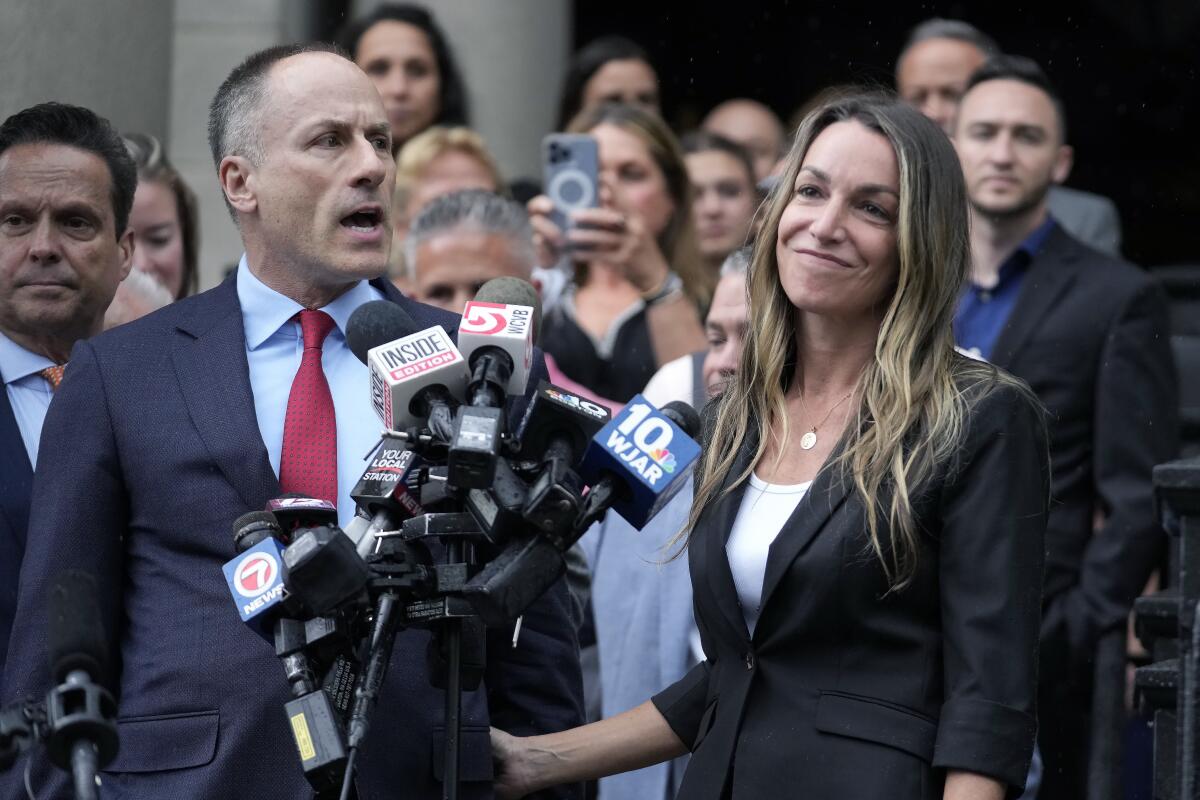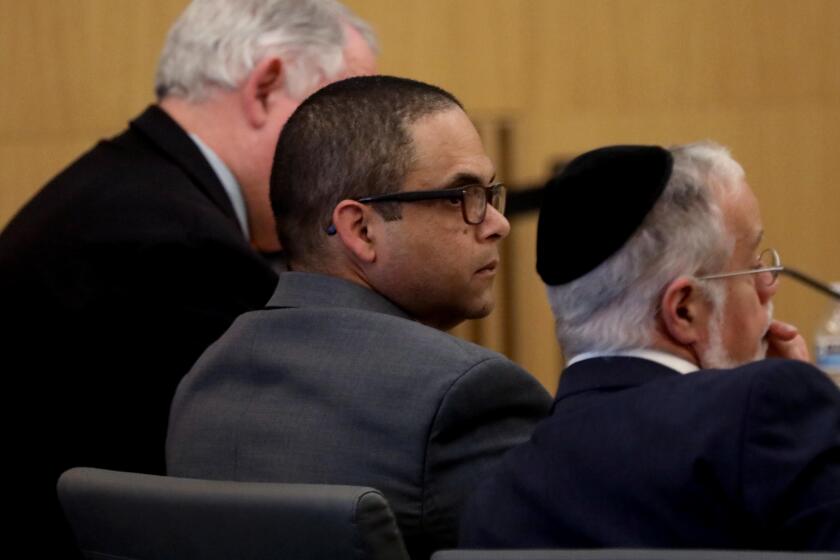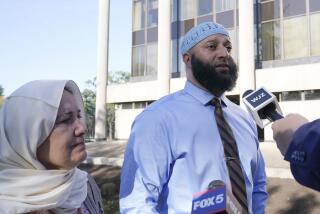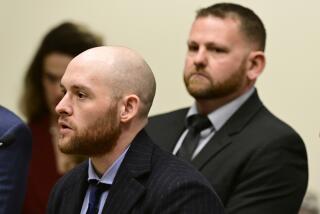Karen Read murder case ends in a mistrial. Prosecutors say they will try again

- Share via
DEDHAM, Mass. — A judge declared a mistrial Monday after jurors deadlocked in the case of Karen Read, a woman accused of killing her Boston police officer boyfriend by striking him with her SUV and leaving him in a snowstorm, a case that drew outsize attention thanks to true crime fanatics, conspiracy theorists and Read’s pink-shirted supporters.
Prosecutors said in a statement that they intend to retry the case.
Read, a former adjunct professor at Bentley University, faced second-degree murder and other charges in the death of Officer John O’Keefe, a 16-year member of the Boston police who was found outside a Canton home of another Boston police officer in January 2022. An autopsy found O’Keefe died of hypothermia and blunt force trauma.
Prosecutors said Read and O’Keefe had been drinking heavily before she dropped him off at a party at the home of Brian Albert, a fellow officer. They said she hit him with her SUV before driving away.
The defense sought to portray Read as the victim, saying O’Keefe actually had been killed inside Albert’s home and then dragged outside and left for dead. They argued that investigators focused on Read because she was a “convenient outsider” who saved them from having to consider other suspects, including Albert and other law enforcement officers at the party.
A judge has vacated Sandra Hemme’s conviction in the Nov. 13, 1980, killing of library worker Patricia Jeschke, 31. Hemme’s attorneys blame the slaying on Michael Holman, a discredited police officer who died in 2015.
On Friday, a jury foreperson told the judge that they hadn’t reached a unanimous verdict despite an “exhaustive review of the evidence.” The judge told jurors to keep trying. On Monday morning, jurors said they were at an impasse, but the judge asked them to continue deliberating. In the afternoon, they said it would be futile to continue.
“The deep division is not due to a lack of effort or diligence but rather a sincere adherence to our individual principles or moral convictions,” the jury said in a note read by the judge in court.
O’Keefe’s mother cried after the mistrial was declared, while Read hugged her father and other relatives.
The Norfolk County district attorney’s office said in a statement: “First, we thank the O’Keefe family for their commitment and dedication to this long process. They maintained sight of the true core of this case — to find justice for John O’Keefe. The Commonwealth intends to re-try the case.”
Defense attorney Alan Jackson said he and others representing Read will keep fighting.
New attorneys for Rebecca Grossman say prosecutors failed to prove she acted with implied malice and that erroneous evidence was admitted in her trial.
“They failed. They failed miserably, and they’ll continue to fail. No matter how long it takes, no matter how long they keep trying, we will not stop fighting,” he told reporters outside court.
Testimony during the two-month trial focused on shoddy police work and relationships between the parties. Police acknowledged using red plastic cups to collect blood evidence and a leaf blower to try to clear away snow to reveal evidence. The lead investigator acknowledged making crude statements about Read in texts from his personal cellphone.
Experts disagreed on whether O’Keefe’s injuries were consistent with being hit by Read’s luxury SUV, which had a broken taillight. The defense contended the injuries were caused by an altercation and the Albert family’s aggressive dog.
While the drama played out in a courtroom, dozens of Read’s supporters dressed in pink gathered each day outside, carrying “Free Karen Read” signs and mobbing her when she arrived each day. Motorists honked their horns in support. A smaller group of people who want Read convicted also turned up.
Another lawyer representing Read, David Yannetti, said he was in awe of his client’s “strength and courage” and praised those who have backed her before and during the trial.
Jurors said they were hopelessly deadlocked in the trial of former Long Beach school officer Eddie Gonzalez, who fatally shot Manuela ‘Mona’ Rodriguez.
“Your support was invaluable,” he said. “We are touched and we ask for your continued support.”
Prosecutors relied on several first responders who testified that Read admitted that she hit O’Keefe — saying “I hit him” — as well as evidence that Read was legally intoxicated or close to it eight hours later, after she returned to the house with friends and they found the body.
Several witnesses testified the couple had a stormy relationship that had begun to sour. Prosecutors presented angry texts between the couple hours before O’Keefe died. They also played voice messages from Read to O’Keefe that were left after she allegedly struck him, including one left minutes afterward saying, “John I (expletive) hate you.”
Defense attorneys sought to poke holes in the police investigation, noting that Albert’s house was never searched for signs of a fight involving O’Keefe and that the crime scene was not secured. They suggested that some evidence — such as pieces of her SUV’s cracked taillight, a broken drinking glass and even a strand of hair — was planted by police.
The Alex Murdaugh murder trial has fueled a cottage industry, including a beneficial relationship between live trial coverage and feuding docuseries.
A turning point in the trial came when the lead investigator, State Trooper Michael Proctor, took the stand. He acknowledged sending offensive texts about Read to friends, family and fellow troopers during the investigation. He apologized for the language he used but insisted they had no influence on the investigation.
In his texts, he called Read several names, including “whack job.” At one point, he texted his sister that he wished Read would “kill herself,” which he told jurors was a figure of speech. And despite having relationships with several witnesses, he remained on the case.
Two expert witnesses hired by the U.S. Department of Justice during an investigation of police handling of the case testified for the defense, providing a scientific analysis for their conclusion that O’Keefe’s injuries and the physical evidence didn’t sync with the prosecution theory that he was struck and injured by Read’s 7,000-pound vehicle.
O’Keefe had a significant head injury and other injuries but lacked significant bruising or broken bones typically associated with being hit by a vehicle at the speed indicated by GPS and the SUV’s onboard computer.
Casey writes for the Associated Press.
More to Read
Sign up for Essential California
The most important California stories and recommendations in your inbox every morning.
You may occasionally receive promotional content from the Los Angeles Times.














